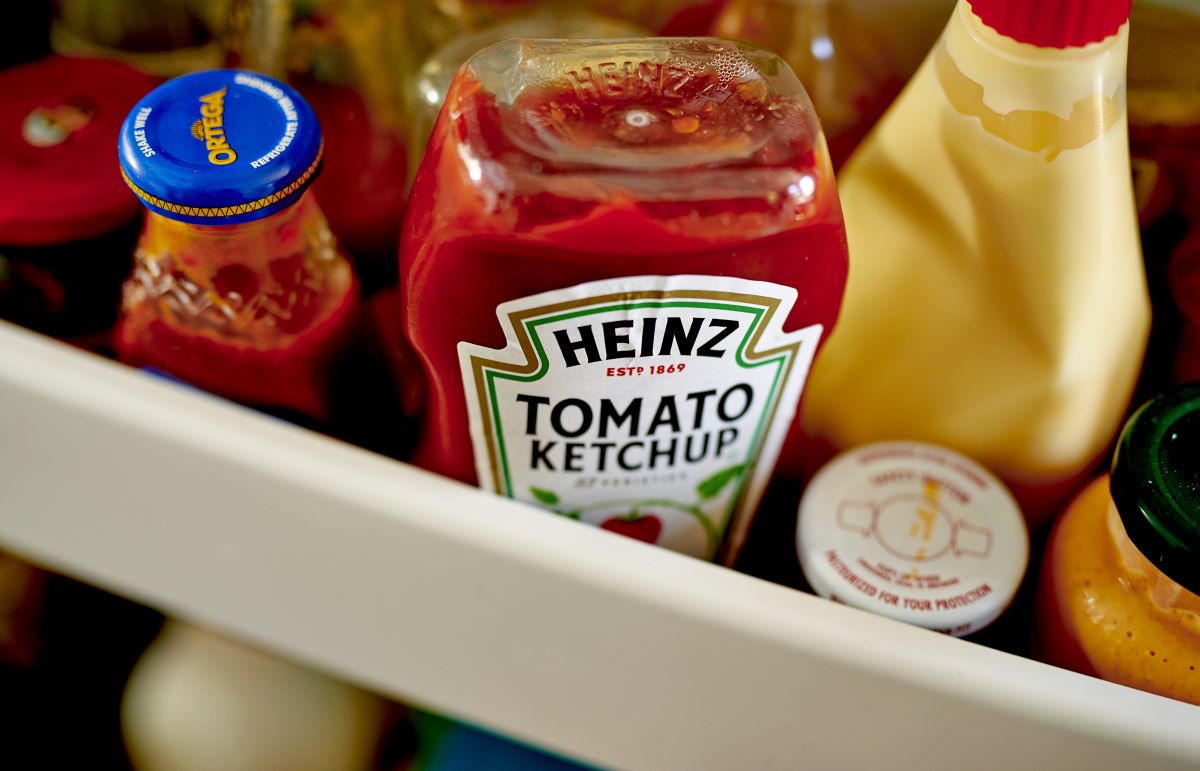

Articles
How To Store Hot Dogs After Opening
Modified: October 20, 2024
Discover the best ways to store hot dogs after opening with our informative articles. Keep your hot dogs fresh and flavorful for longer. Learn more now!
(Many of the links in this article redirect to a specific reviewed product. Your purchase of these products through affiliate links helps to generate commission for Storables.com, at no extra cost. Learn more)
Introduction
Hot dogs are a beloved food enjoyed by people all over the world. Whether you enjoy them at a summer barbecue, a sports event, or simply as a quick snack, it’s important to know how to properly store them after opening. Proper storage not only ensures that your hot dogs remain safe to eat, but also helps maintain their quality and flavor.
In this article, we will explore the various ways you can store hot dogs after opening the package. We will discuss general tips for storage, as well as specific options such as refrigeration, freezing, canning, vacuum sealing, and using airtight containers. We will also touch on the importance of labeling and dating your stored hot dogs, as well as tips for reheating them to enjoy later.
By understanding how to store hot dogs properly, you can avoid waste, save money, and always have a delicious and convenient meal option available. So let’s dive in and learn the best practices for storing hot dogs after opening!
Key Takeaways:
- Properly storing hot dogs after opening is crucial for maintaining safety, flavor, and quality. Options include refrigeration, freezing, canning, vacuum sealing, and using airtight containers. Labeling and dating stored hot dogs is essential for food safety and quality control.
- When reheating stored hot dogs, ensure they are thoroughly heated using methods such as boiling, grilling, microwaving, or steaming. Serve with favorite toppings for a delicious meal. Always trust your senses and discard any spoiled hot dogs.
Read more: How To Store Bacon After Opening
Why Proper Storage is Important
Proper storage of hot dogs is crucial for maintaining their safety and quality. When hot dogs are exposed to air, moisture, and fluctuating temperatures, they become susceptible to bacterial growth, oxidation, and loss of flavor. It’s essential to store them in a way that minimizes these risks and extends their shelf life.
Foodborne illnesses can occur if hot dogs are not stored properly. Bacteria such as Salmonella, E. coli, and Listeria monocytogenes can contaminate hot dogs and cause food poisoning. Symptoms of foodborne illnesses may include diarrhea, nausea, vomiting, abdominal cramps, and fever, and they can range from mild to severe, depending on the type of bacteria involved and individual susceptibility.
In addition to protecting your health, proper storage also helps preserve the flavor and texture of hot dogs. Exposure to air can lead to oxidation, which causes the hot dogs to become discolored and develop an off taste. Proper storage prevents this oxidation process and ensures that your hot dogs retain their fresh and delicious flavor.
Furthermore, by storing hot dogs properly, you can reduce food waste and save money. When hot dogs spoil or lose their quality due to improper storage, you may find yourself throwing them away and needing to purchase new ones. By following the correct storage guidelines, you can extend the shelf life of your hot dogs and make the most of your purchase.
Overall, proper storage of hot dogs is essential for maintaining food safety, preserving flavor, reducing waste, and saving money. By implementing the techniques and tips outlined in this article, you can protect yourself and your loved ones from foodborne illnesses, enjoy hot dogs that taste their best, and make the most of your food investment. So let’s explore the different methods for storing hot dogs after opening the package!
General Tips for Storing Hot Dogs After Opening
When it comes to storing hot dogs after opening the package, there are a few general tips that you should keep in mind. These tips will help you maintain the quality, flavor, and safety of your hot dogs for an extended period of time. Here are some guidelines to follow:
1. Transfer to airtight packaging: After opening the package, it’s important to transfer the hot dogs to airtight packaging. This helps to prevent exposure to air, which can lead to oxidation and loss of flavor. Use resealable plastic bags, food storage containers, or aluminum foil to keep the hot dogs tightly sealed.
2. Store in the refrigerator or freezer: Hot dogs should be stored in either the refrigerator or freezer, depending on your intended storage duration. If you plan to consume the hot dogs within a few days, refrigeration is sufficient. For longer storage, freezing is the best option.
3. Follow recommended temperature: Ensure that your refrigerator is set to a temperature below 40°F (4°C) to keep your hot dogs fresh and safe. Freezers should be set to at least 0°F (-18°C) to maintain the quality of frozen hot dogs.
4. Keep away from strong odors: Hot dogs have a tendency to absorb strong odors from other foods in the fridge. To prevent this, store them separately or in a designated section of the refrigerator. This will help maintain the original taste and aroma of the hot dogs.
5. Avoid cross-contamination: To prevent cross-contamination, it’s important to store hot dogs separately from raw meat, poultry, and seafood. This will minimize the risk of bacterial contamination and maintain the integrity of both types of food.
6. Check for signs of spoilage: Before consuming or reheating stored hot dogs, always check for signs of spoilage. Look for discoloration, a slimy texture, or a foul odor. If you notice any of these signs, discard the hot dogs immediately to avoid foodborne illness.
By following these general tips, you can ensure that your hot dogs remain fresh, safe to eat, and packed with flavor. Now that we’ve covered the basics, let’s explore some specific storage options for hot dogs after opening the package.
Option 1: Refrigerating Hot Dogs
Refrigeration is one of the most common and convenient methods for storing hot dogs after opening the package. By following a few simple steps, you can keep your hot dogs fresh and ready to enjoy for several days. Here’s how to refrigerate hot dogs:
1. Transfer to airtight packaging: After opening the package, transfer the hot dogs to an airtight container or resealable plastic bag. This will help maintain their freshness and prevent them from absorbing odors from other foods in the refrigerator.
2. Label and date: To keep track of the storage duration, it’s important to label the container or bag with the date of storage. Hot dogs stored in the refrigerator are typically safe to consume within 3-5 days.
3. Store in the refrigerator: Place the airtight container or bag of hot dogs in the refrigerator, preferably on a shelf rather than in the door. The consistent temperature of the refrigerator will help keep the hot dogs fresh and safe to eat.
4. Avoid frequent temperature fluctuations: To maintain the quality and safety of the hot dogs, it’s important to avoid frequent temperature fluctuations. Be sure to close the refrigerator door tightly and avoid frequent opening and closing, as this can lead to temperature changes that may shorten their shelf life.
5. Keep away from raw meat: To prevent cross-contamination, store the hot dogs separately from raw meat, poultry, and seafood. This reduces the risk of bacterial transfer and helps maintain the flavor and quality of both types of food.
6. Check for signs of spoilage: Before consuming or reheating refrigerated hot dogs, always check for signs of spoilage. If the hot dogs have an off color, slimy texture, or a foul odor, discard them immediately to avoid foodborne illnesses.
Refrigerating hot dogs is a convenient option for short-term storage. It allows you to enjoy your hot dogs for a few days while maintaining their quality and safety. However, if you need to store hot dogs for a longer period, freezing is the preferred method. In the next section, we will explore how to freeze hot dogs for extended storage.
Option 2: Freezing Hot Dogs
If you want to store hot dogs for an extended period, freezing is the optimal option. Freezing not only keeps the hot dogs safe to eat for a longer duration but also helps preserve their flavor and texture. Here’s how you can freeze hot dogs:
1. Wrap individually: Before freezing, it’s best to wrap each hot dog individually. This prevents them from sticking together and makes it easier to thaw the desired amount when needed. You can use plastic wrap, aluminum foil, or freezer-safe bags for wrapping.
2. Label and date: To keep track of the storage duration, label each wrapped hot dog with the date of freezing. Hot dogs stored in the freezer can remain safe for consumption for up to 2-3 months.
3. Place in a freezer-safe container: Once the hot dogs are individually wrapped, place them in a freezer-safe container or bag. This provides an additional layer of protection against freezer burn and helps maintain their quality.
4. Remove excess air: If using a bag or container, remove excess air before sealing to prevent freezer burn. You can use a vacuum sealer or the “burping” method by gently squeezing out the air and sealing the bag or container tightly.
5. Store in the freezer: Place the wrapped hot dogs in the freezer, preferably in a single layer for efficient freezing. Avoid overcrowding to ensure uniform freezing and to maintain the quality of the hot dogs.
6. Thawing frozen hot dogs: When you’re ready to use the frozen hot dogs, you can thaw them in the refrigerator overnight or in cold running water. Avoid thawing at room temperature to minimize the risk of bacterial growth.
It’s important to note that freezing may slightly affect the texture of hot dogs. They may become slightly mushy upon thawing, but this typically doesn’t impact their taste or safety. Once thawed, you can cook the hot dogs using your preferred method, whether grilling, boiling, or microwaving.
Freezing hot dogs is a great option when you want to store them for an extended period. It allows you to stock up on hot dogs and enjoy them at your convenience without worrying about spoilage. Next, we will explore an alternative method: canning hot dogs.
Read more: How To Store Caulk After Opening
Option 3: Canning Hot Dogs
Canning hot dogs is another method for long-term storage, allowing you to preserve their flavor and texture. While it may require a bit more effort, canning offers the advantage of shelf-stable convenience. Here’s how you can can hot dogs:
1. Prepare the canning supplies: To can hot dogs, you will need canning jars, lids, and bands. Make sure they are clean and sterilized according to proper canning procedures.
2. Cook the hot dogs: Before canning, cook the hot dogs thoroughly. You can boil, steam, or grill them until they are fully cooked. This step ensures that the hot dogs are safe to eat after canning.
3. Pack the jars: Place the cooked hot dogs into the sterilized canning jars, leaving about 1 inch of headspace at the top. You can cut the hot dogs to fit the jars if needed.
4. Add liquid: To prevent dryness and enhance flavor, you can add a liquid to the jars. This can be a combination of water, broth, or brine. Ensure that the liquid covers the hot dogs, leaving the proper headspace.
5. Remove air bubbles: Use a clean utensil to remove any air bubbles trapped inside the jars. This helps maintain the quality of the hot dogs and prevents spoilage.
6. Seal and process: Place the lids and bands on the jars and tighten them securely. Follow the appropriate canning method for hot dogs, whether it’s a water bath canning or pressure canning process. Refer to reliable canning resources or consult with local food preservation experts for specific instructions.
7. Cool and store: Once the jars have been properly processed, allow them to cool completely. Check the lids for a proper seal before storing the jars in a cool, dry place away from direct sunlight. Canned hot dogs can typically be stored for up to a year or more.
When you’re ready to enjoy the canned hot dogs, simply open the jar, drain any liquid, and heat them according to your preference. They can be heated on the stovetop, grilled, or microwaved.
Canning hot dogs may require more time and effort compared to other storage methods, but it offers the advantage of long-term shelf stability. If canning interests you, be sure to follow proper canning procedures to ensure the safety and quality of the canned hot dogs.
Store opened hot dogs in an airtight container or resealable plastic bag in the refrigerator. Use them within 3-5 days for best quality.
Option 4: Vacuum Sealing Hot Dogs
Vacuum sealing is an effective method for preserving the freshness and quality of hot dogs. By removing all the air from the packaging, vacuum sealing helps to prevent oxidation, freezer burn, and bacterial growth. Here’s how you can vacuum seal hot dogs:
1. Prepare the vacuum sealer: Ensure that your vacuum sealer is clean and in proper working condition. You will also need vacuum seal bags or rolls specifically designed for use with your vacuum sealer machine.
2. Portion and pack the hot dogs: Divide the hot dogs into desired portions. Place each portion in a vacuum seal bag or roll, leaving enough space at the top for sealing. It’s advisable to wrap the hot dogs tightly or use separate pouches for each portion to prevent them from sticking together.
3. Seal the bags: Place the open end of the vacuum seal bag or roll into the vacuum sealer machine. Follow the manufacturer’s instructions to seal the bags. The machine will remove the air from the bag and create an airtight seal.
4. Label and date: Once the bags are sealed, label them with the contents and date of packaging. Properly labeling the bags will help you keep track of the storage duration and ensure that the oldest hot dogs are used first.
5. Store in the refrigerator or freezer: Depending on your intended storage duration, you can store the vacuum-sealed hot dogs in the refrigerator or freezer. If you plan to consume them within a few days, refrigeration is sufficient. For longer storage, freezing is recommended.
6. Thawing the vacuum-sealed hot dogs: When you’re ready to use the vacuum-sealed hot dogs, they can be thawed by placing them in the refrigerator overnight or using the defrost function on your microwave. You can also cook them directly from frozen in boiling water or on the grill, as vacuum-sealed packaging helps retain moisture and prevents freezer burn.
Vacuum sealing hot dogs provides excellent protection against air exposure, which helps maintain their quality and freshness. It also allows you to portion the hot dogs and store them conveniently. Whether you choose to refrigerate or freeze the vacuum-sealed hot dogs, they will be well-preserved until you’re ready to enjoy them.
Next, let’s explore another option for storing hot dogs: using airtight containers.
Option 5: Using Airtight Containers
Using airtight containers is a simple and convenient method for storing hot dogs after opening the package. Airtight containers help to preserve the flavor, texture, and freshness of hot dogs while protecting them from exposure to air and moisture. Here’s how you can use airtight containers to store hot dogs:
1. Transfer to airtight containers: After opening the package, transfer the hot dogs to clean and dry airtight containers. These can be plastic or glass containers with tight-fitting lids. Make sure the containers are food-grade and free from any cracks or damage.
2. Divide into portions: If you prefer to portion your hot dogs, you can separate them into individual servings or desired portions before placing them in the containers. This will make it easier to thaw and use the hot dogs as needed.
3. Label and date: To keep track of the storage duration, label the containers with the contents and date of storage. Hot dogs stored in airtight containers are typically safe to consume within 3-5 days. Proper labeling helps you identify the oldest hot dogs and use them first.
4. Close the lids tightly: Ensure that the lids of the airtight containers are securely closed to create a tight seal. This prevents air from entering the containers and helps maintain the quality of the hot dogs.
5. Store in the refrigerator: Place the airtight containers of hot dogs in the refrigerator, preferably on a shelf rather than in the door. The consistent temperature of the refrigerator will help keep the hot dogs fresh and safe to eat.
6. Check for spoilage: Before consuming or reheating stored hot dogs, always check for signs of spoilage. If the hot dogs have an off color, slimy texture, or a foul odor, discard them immediately to avoid foodborne illnesses.
Using airtight containers is a convenient option for short-term storage of hot dogs. It allows you to keep them fresh and easily accessible in the refrigerator. However, if you need to store hot dogs for a longer duration, consider options like freezing, canning, or vacuum sealing, as discussed earlier in this article.
Now that we have explored various methods of storing hot dogs after opening, it’s important to discuss the importance of labeling and dating your stored hot dogs. Let’s move on to the next section.
Importance of Labeling and Dating
Labeling and dating your stored hot dogs is a crucial step in ensuring food safety and maintaining organization in your storage practices. Here are the reasons why labeling and dating are important:
1. Food safety: Labeling and dating your stored hot dogs helps you keep track of the storage duration and determine whether they are still safe to consume. By clearly indicating the date of storage, you can avoid consuming hot dogs that have exceeded their recommended shelf life. This reduces the risk of foodborne illnesses caused by consuming spoiled or expired food.
2. Quality control: Proper labeling allows you to identify and use the oldest hot dogs first. By rotating your stock based on the storage date, you can prioritize the consumption of hot dogs that are closer to their expiration date. This ensures that you are enjoying the freshest hot dogs and minimizing food waste.
3. Easy identification: Labeling your hot dog containers or packages provides convenience and ease of identification. By clearly indicating the contents, you can quickly locate and retrieve the desired portion of hot dogs from your storage. This saves time and eliminates the need for guesswork.
4. Inventory management: Labeling and dating your hot dogs help you keep track of your inventory and avoid unnecessary purchases. By knowing exactly how many hot dogs you have and when they were stored, you can plan your meals accordingly and avoid overstocking.
5. Allergen management: If you have different types of hot dogs or if someone in your household has food allergies, labeling is especially important. Clearly indicating the type of hot dogs or any potential allergens can prevent accidental consumption and allergic reactions.
When labeling your hot dogs, include essential information such as the date of storage, type of hot dogs (e.g., beef, pork, chicken), and any relevant details such as additives or spices. You can use stickers, markers, or adhesive labels to label your containers or write directly on the packaging.
Remember to always follow proper storage guidelines and discard any hot dogs that show signs of spoilage, even if they are within the recommended storage period.
Labeling and dating your stored hot dogs is a simple yet effective practice that promotes food safety, quality control, and efficient inventory management. By incorporating this step into your storage routine, you can ensure that your hot dogs remain safe, fresh, and enjoyable for optimal consumption.
Read more: How To Store Tahini After Opening
Tips for Reheating Stored Hot Dogs
When it’s time to enjoy your stored hot dogs, proper reheating is key to ensure they are safe to eat and delicious. Here are some helpful tips for reheating hot dogs that have been stored:
1. Thaw before reheating: If your hot dogs were stored in the freezer, make sure to thaw them before reheating. Thawing in the refrigerator overnight is the safest method, as it allows for gradual thawing and minimizes the risk of bacterial growth.
2. Boiling: One of the most common methods for reheating hot dogs is boiling. Simply place the hot dogs in a pot of boiling water for about 5 minutes or until they are fully heated through. This method helps to retain the moisture and flavor of the hot dogs.
3. Grilling or pan-frying: For an added smoky flavor and charred texture, you can grill or pan-fry the hot dogs. Preheat the grill or a skillet over medium heat and cook the hot dogs for a few minutes on each side until heated through and lightly browned. This method gives the hot dogs a deliciously grilled taste.
4. Microwave: If you’re in a hurry, microwaving can be a quick and convenient way to reheat hot dogs. Place the hot dogs on a microwave-safe plate and heat them on high for about 30 seconds to 1 minute, or until they are thoroughly heated. Be cautious not to overcook them, as they may become rubbery.
5. Steaming: Steaming is another option for reheating hot dogs. Simply place the hot dogs in a steamer basket and steam them for about 5 minutes or until heated through. This method helps to retain moisture and prevents the hot dogs from becoming dry.
6. Don’t reheat excessively: It’s important not to overheat hot dogs, as this can cause them to become tough and lose their flavor. Heat them just until they are heated through to maintain their juicy and tender texture.
7. Serve with your favorite toppings: Once reheated, serve your hot dogs with your favorite toppings and condiments such as mustard, ketchup, relish, onions, or sauerkraut. This will enhance the flavor and make them even more enjoyable.
Remember, reheated hot dogs should be consumed immediately after heating for the best taste and texture. Discard any leftovers that have been reheated but not consumed to avoid foodborne illnesses.
By following these tips, you can safely and effectively reheat your stored hot dogs, ensuring a delicious and satisfying meal each time. Enjoy your reheated hot dogs with confidence and savor the convenience of having them readily available in your storage.
Conclusion
Properly storing hot dogs after opening the package is essential for maintaining their safety, flavor, and quality. Whether you choose to refrigerate, freeze, can, vacuum seal, or use airtight containers, each method has its advantages and is suitable for specific storage durations. By following the tips outlined in this article, you can ensure that your hot dogs remain fresh and delicious for extended periods, reducing waste and saving money.
Refrigeration is a convenient option for short-term storage, while freezing allows for longer-term preservation. Canning provides the advantage of shelf-stability, and vacuum sealing maximizes freshness. Airtight containers offer simplicity and organization. Regardless of the method you choose, labeling and dating your stored hot dogs is crucial for food safety, quality control, and inventory management.
When it comes time to enjoy your stored hot dogs, reheating them properly is key. Whether boiling, grilling, pan-frying, microwaving, or steaming, make sure to heat the hot dogs until they are thoroughly heated without overcooking them. Serving them with your favorite toppings and condiments enhances the flavor and completes the meal.
Remember, safety should always be a priority. Discard any hot dogs that show signs of spoilage, such as discoloration, slimy texture, or a foul odor. It’s essential to trust your senses and err on the side of caution when it comes to consuming stored food.
By implementing these storage and reheating techniques, you can enjoy your hot dogs at your convenience, minimize food waste, and ensure a delicious and safe dining experience. So whether you’re preparing for a summer barbecue, packing lunches, or simply stocking up on hot dogs, use these tips to store and enjoy this beloved food with confidence.
Frequently Asked Questions about How To Store Hot Dogs After Opening
Was this page helpful?
At Storables.com, we guarantee accurate and reliable information. Our content, validated by Expert Board Contributors, is crafted following stringent Editorial Policies. We're committed to providing you with well-researched, expert-backed insights for all your informational needs.














0 thoughts on “How To Store Hot Dogs After Opening”